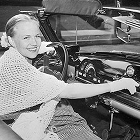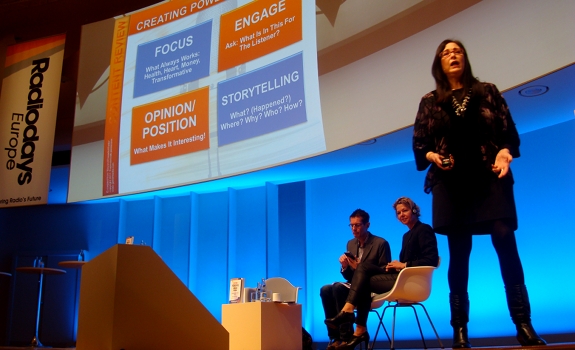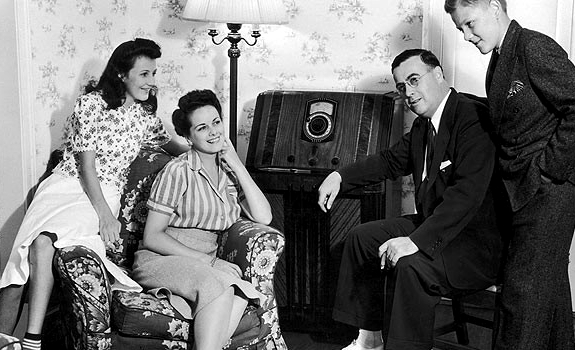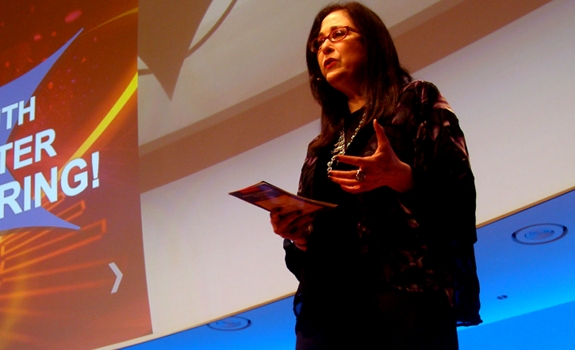Creative storytelling = powerful radio, but that’s only possible when program directors give their on-air talents a license to try and to fail, says radio consultant Valerie Geller.
Radiodays Europe 2013 had a fun session with Valerie Weber & Valerie Geller who were sharing the best storytelling techniques for radio. Geller spoke about creating powerful radio content and making your audience open-minded for it, plus: how to let radio personalities excel in creativity. “Never take the brush out of the hand of the artist.”
“Radio isn’t about radio”

Radio consultant Valerie Geller (left), here on stage with ANTENNE BAYERN program director Valerie Weber and the session host, makes clear that radio is first and foremost about listener companionship (photo: Thomas Giger)
Help audience master life
“There’s never been a more exciting time to work in radio”, says Valerie Geller who is consulting radio stations and training broadcasters all over the world to become better communicators. In her view, today’s multi-platform media landscape offers a lot of opportunity to deliver our content to the audience. The basics, however, will always be the same: “Radio isn’t about radio. Radio is about people and life, and the struggle to be a human being – ‘let’s help each other to get through another day’. It just does that with a microphone. Our job is to inform, entertain, inspire, persuade, and connect the audience to life.”
 Be your listener’s friend
Be your listener’s friend
The radio consultant reminds us of what radio means to someone who is alone in a room or in a car, or just feels alone. In other words: radio is there to offer people pleasant companionship. “That’s the gift that we give to our audience.” In a time when people find music and news anywhere online, she thinks that powerful storytelling is the unique selling proposition of the classic medium of radio that will keep it alive.
Combine visual & emotional words
It’s a known fact that radio is a theatre of the mind, where we use words to paint pictures in people’s minds, but Geller is using brain science to explain why. Functional MRI shows that the learning centers in male brains light up when they are given a verbal picture. Another interesting insight is that the female brain likes visuals, too, but responds even stronger to feelings. To open up and receive information, men need a picture and women need emotion. Valerie and I know each other from an interview a couple of years earlier, and as I sat in the front row during her session she used me as an example to illustrate this funny Mars-Venus phenomenon:
[audio:http://www.radioiloveit.com/wp-content/uploads/valerie-geller-radio-consultant-radiodays-europe-2013-01.mp3|titles=Valerie Geller explains how to condition male and female listeners]
“There are no boring stories,
only boring storytellers”

Valerie Geller (right) is convinced that any topic can be interesting – as long as you make your listeners care about it, by forming a opinion about or taking a position towards the subject before you put it on air (photo: Thomas Giger)
Focus, engage, position, tell
‘Tell the truth, make it matter, and never be boring’ is Valerie Geller’s well-know mantra, and her model to go even beyond powerful radio is based on the following 4 elements:
1. Focus
The main question to determine whether a topic is interesting, relevant and matters, is to ask yourself if it’s a story you would tell a friend, and if people will be likely to share this story with their friends. Her basic rule is that: “when you speak about it off the air, it will probably work on the air.” Apart from that, there are 4 universal topics that people find interesting – no matter where they live:
- Health (including wellbeing and safety)
- Heart (emotions)
- Money (including power and politics)
- Transformation (including personal development)
2. Engage
Always speak to one person at a time and/or use the word you – instead of I, me, we, us or our.
- Instead of “We have tickets to give away”, say “You can win tickets”
- Instead of “I’m standing here in a snowstorm”, say “If you look outside, do you see the snowstorm?”
3. Opinion / position
Although opinions don’t belong inside the news, you do have to think about a topic enough to form your personal opinion about or determine your individual position towards the story, because only then you’ll be able to (make your listener) care about it while presenting it on air. “There are no boring stories, only boring storytellers. If you care, you will find a way to make the audience care.”
4. Storytelling
The radio consultant advises to start with the best material and to show the listener’s benefit right away. “Before you even utter one word on the radio, ask: why should someone listen to this? Or imagine a neon sign, flashing: ‘Here’s why you need to listen to this’ – and whatever you say next should be your opening line.” She recalls how this 4-step model helped a US talk show host to communicate much better:
[audio:http://www.radioiloveit.com/wp-content/uploads/valerie-geller-radio-consultant-radiodays-europe-2013-02.mp3|titles=Valerie Geller shares how to paint pictures by using words]
“If you do this one thing,
you can break every rule in radio”

Humor is the key to open people’s minds and make the receptive for your radio story (photo: Aninkaisten Rytmi)
Start with the ‘what’
According to Geller, the 6 questions to answer in every news story (who, what, where, when, why, and how) are also useful elements of radio storytelling. However, the order should be different from written articles. Newspaper and magazine stories are often based on the inverted pyramid structure, but a radio story should begin with the what, instead of the who, the radio consultant explains:
[audio:http://www.radioiloveit.com/wp-content/uploads/valerie-geller-radio-consultant-radiodays-europe-2013-03.mp3|titles=Valerie Geller names differences between written and spoken communication]
 Have some fun, too!
Have some fun, too!
“If you do this one thing, you can break every rule in radio”, Valerie Geller says in reference to humor. Brain research shows that when people laugh, their brains fill up with endorphin, which makes them feel good and opens up their learning centers. “It’s why comedians can do very difficult topics that no other person could speak about, because you are laughing while you are talking about these things.”
Offer possible problem solutions
Knowing that what radio listeners dislike the most are boring content and (too) depressing content, Geller is convinced that in terms of news stories, radio stations should not only talk about problems. In her opinion it’s important to offer solutions (or at least perceived solutions) as well, like an expert who is interviewed about how that situation could be solved. This will create a positive or constructive mood for your listeners. “Leave them hopeful.”
“Use your ears and
be a spy in the world”

Eavesdropping on daily conversations between people in public places can give you tons of ideas for program content and discussion topics for your radio show, international radio consultant Valerie Geller says (photo: Thomas Giger)
Make life your showprep
Of course, you can use current events and news topics for your radio program. Valerie Geller has just one condition: “Would you be talking about this off air?” If the answer is yes, she thinks it could be a good topic. But she believes even more in personal surroundings as creative well – making individual experience the number 1 source for radio showprep: “In addition to what’s going on, use the stories from your life. That personal is universal; if it happens to you, it happens to others.”
 Eavesdrop on everyday conversations
Eavesdrop on everyday conversations
Furthermore, Geller considers overheard or observed situations from daily life as a treasure for radio content ideas: “If you can use your ears and be a spy in the world, you can come up with great topics.” She has worked with a Canadian radio producer who always gets her best topic ideas by listening to conversations in a coffee bar – while standing in the waiting line along with other people:
[audio:http://www.radioiloveit.com/wp-content/uploads/valerie-geller-radio-consultant-radiodays-europe-2013-04.mp3|titles=Valerie Geller portraits how life observations lead to creative radio]
Build a creative-friendly environment
Despite many possibilities to make fantastic radio, Valerie Geller knows that “it takes great courage to be creative” because “the number one thing that holds creative people back from greatness is the fear of failure or looking foolish in the eyes of others. Our job as leaders in broadcasting is to give people paints, paintbrushes and canvas and say to them: paint the picture as you see it. Never take the brush out of the hand of the artist.” Instead, she pleads that program directors give radio talents creative freedom, and even more than that: radio personalities should be given a permission to fail:
[audio:http://www.radioiloveit.com/wp-content/uploads/valerie-geller-radio-consultant-radiodays-europe-2013-05.mp3|titles=Valerie Geller stresses the importance of giving creative people space]





Pleasure, Valerie.
For people interested: I’ve put links to Valerie’s books, including this new one, in the article above as they might be good resources for you. You’ll also find them in our list of radio books.
Thanks for an inspiring talk! And I now have enough milk in the fridge for at least 2 weeks :D.
Best regards,
Thomas
Thank you, Thomas!
Just in case anyone is interested, there is much more on this in the book, ‘Beyond Powerful Radio – A Communicators Guide to the Internet Age’, published by Focal Press.
Thank you again for coming to the session, and sharing this with radio people!